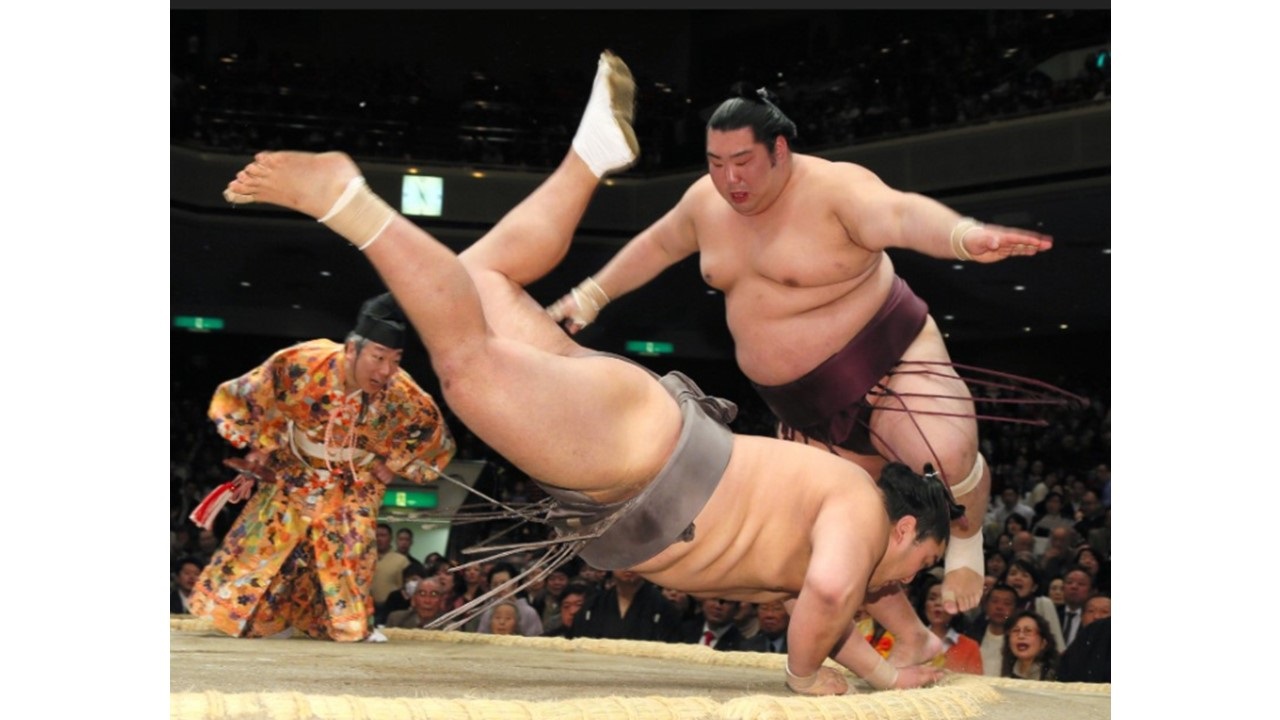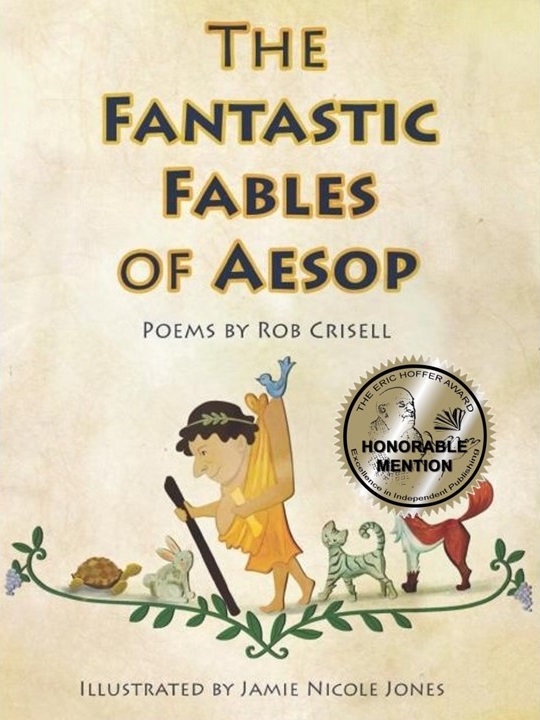.
Sumo’s Winning Ways
Fierce frontal impact clenches victory
In less time than an untrained eye can blink,
But connoisseurs of sumo’s treasury
Prefer discriminating knack. They wink
When force through fine technique shows mastery.
Drive into the opponent, pull him close,
Then push him, force him, thrust him, crush him out,
Or pull or slap him down to hard-packed dirt.
Twist, pivot, lock his arm or head—and throw!
Throw with authority, because the aim
Is winning! Seconds in the ring repay
The hours and years spent training. Not a game
Is this; give everything you’ve got to sway
The foe off balance, and your triumph claim.
Throw overarm or underarm or hip;
Use leg trips or a hammer body drop,
A double leg sweep or a hooking twist,
Or all your strength to lift him out—take risks.
The thrill of winning stormy breakneck bouts
By spirit and technique, the fighter’s pride,
Deserves his effort and the viewers’ shouts;
His body’s massive learning can decide
Contentions won through sudden whirlabouts.
To size and strength and speed and skill, add stealth.
Surprises win: a dodge or jump or block;
Clap hands in the rival’s face, or slap it hard;
An ankle pick can do the cheeky trick.
New moves that foreign wrestlers introduce,
Reviving clever clashes of the past,
Shock all who let them fall into disuse.
Be quick to study; make a counterblast
Bold, common, unexpected, or abstruse:
The backward belt toss, pulling body slam,
Rear lean out, grabbing arm thrust, thigh-scoop throw.
Two-handed head twists torque a man aground;
The Triple rams the chest and whips both legs.
Charge forward, building power, champions say:
Attack and grip; defense is secondary.
Be master of each ordinary way,
And ready with strange tactics legendary
To dominate divinely fiendish fray.
.
.
Margaret Coats lives in California. She holds a Ph.D. in English and American Literature and Language from Harvard University. She has retired from a career of teaching literature, languages, and writing that included considerable work in homeschooling for her own family and others.















I really enjoyed reading this poem, Margaret. An interesting subject that I knew nothing about. Well written!
Thanks, Russel. It’s great to know that someone who knew nothing about sumo really enjoyed reading my sumo poem!
I smiled at:
An ankle pick can do the cheeky trick.
Thanks, Michael. I wanted at least one cheeky expression in the poem. The wrestlers themselves remain calm and collected when they win by an unusual technique, but delighted fans smile, laugh, and shout when they aren’t wearing masks. These days some bring banners with cheeky words they might want to use, and wave them vigorously when they feel like it.
The subject of this poem is so unique, which makes it extra special. I doubt there’s anything like it out there. Were you already familiar with sumo, or did you have to do a bit of research? This would be a wonderful poem to translate. I imagine it would go over well in Japan.
I am a longtime sumo fan, but for this poem I did research on winning techniques. I wanted to include rare ones that I haven’t seen, and to cite a large variety of powerful words. But since the names I use are standard terms employed by English-speaking sports commentators, I don’t imagine my poem would have much appeal if translated into Japanese. I do think a native-speaking Japanese poet could weave a fascinating poem out of his own choice of these techniques, taking into account intriguing sounds and root meanings. I am glad mine has a unique appeal to you. We have a lot of metaphorically fighting poems at SCP, but the only one I recall about physical fighting is Joseph Salemi’s “Golden Gloves.”
Margaret, you took me back to college days, working my part-time job at a Japanese restaurant where the owner, a very traditional Japanese man, would play sumo wresting videos in the foyer. My favorite part was always watching those big dudes slap their buttocks like pawing bulls before they charged. Then, during lunch breaks, the owner’s middle-school son and I would have mock sumo battles in the tatami room. Again, thanks for bringing back memories!
You bring back my memories of watching full-day TV sumo in Japan! There is a lot of psychological warfare in the wrestlers’ preparations for a bout. They slap their bodies, strut around the ring, throw salt, and glare menacingly at one another. In the United States, we get only the highlights of the conflict. If you have NHK World on your TV service, the 15-day summer tournament is on right now. Pacific Time it shows each day’s sumo highlights at 9:30 am, repeated at 4:30 pm. One half-hour packs in all the bouts of the upper division. Now is a good time to start watching, as wrestlers jockey for position on the leader board. The final day is July 24, when the most successful one will take the Emperor’s cup. See you at the arena!
Margaret, your portrayals of Asian life often baffle my mind with your analytical approaches to subjects that are off our western thought radar yet make fascinating reading. Your intricate appraisal of the “art” of Sumo wrestling is intriguing and technically proficient. Thank you for giving us a perspective and appreciation for what transpires.
Roy, you are right that I have an analytical approach to culture. With sumo, there is something universal in the appreciation of technique. This is a martial art, and warriors want to win, but to win in a way that is to their lasting credit. Sloppy technique or breaking the rules will not win lasting victory and cannot achieve the goal. The fighter looks past each bout to the tournament, and then to his career record. The best way to rack up more wins than losses is to be ready for every possible opponent with every possible technique. That’s what we admire, and I’m thankful for your appreciation of my little effort in this poetic endeavor!
Margaret, this is a most unique poem with surprising subject matter. I know of your experience with, and affinity for, Japanese culture but did not see a sumo wrestling poem on the horizon! Your “instruction manual” is amusing, informative and vivid. The architecture of the poem is interesting in the way you alternate tightly rhymed stanzas (5 of them with an a-b-a-b-a pattern) with four 4 -line stanzas in blank verse for a total of 9 stanzas. I don’t know if there is numeric significance to these decisions but I do know that you’re poem mirrors the rigid rituals of sumo which then explode into the chaos of the fight. Well done. And fun!
Having chosen winning techniques as topic, I found it would be very difficult to name many of them in a rhymed poem. There are 82 recognized kimarite, many ending simply with “down,” “out,” or “throw”! But a long stretch of blank verse to accommodate these wouldn’t suit sumo. That’s why I use rhymed stanzas for discourse, separated by unrhymed quatrains to pack in technical terms. As you notice (and so did Evan), this corresponds to the interplay of ritual and battle at a grand sumo tournament. Four is an unlucky number in Japanese, and my four quatrains are full of words that mean defeat for the lucky wrestler’s rival. But five is lucky, and five five-line stanzas offer more good luck than bad. To qualify for professional advancement in a sumo tournament, a wrestler needs “majority wins,” and I have a majority of lucky stanzas here. Tournaments are 15 days long, so I could have written 15 stanzas with 8 of them being 5 lines long, but I have the distinct feeling that 68 lines per poem would win me fewer readers. Thanks for your appreciation of the fun!
Margaret, I too know nothing of Sumo wrestling. I’m ashamed to say I only have vague memories of it on TV when I was in my teens… I sat giggling at their size and attire with little respect for the culture. Your poem has changed all that and I am humbled by the dedication, technique, and mastery involved. I love the use of the onomatopoeic language – I can hear those slaps and claps. I love the monosyllabic locks, twists, throws, drops, trips… all leading up to that glorious portrayal of a sport I have far more respect for having read these wonderful words: “Be master of each ordinary way, /And ready with strange tactics legendary/To dominate divinely fiendish fray.” Margaret – I get it! Thank you!
Thanks a lot, Susan. These wrestlers, even in the lower division, are much more than big guys trying to bulk each other out of a small space. They do formal training three hours a day with their own groups of fellow wrestlers, and weight training on their own. I am even more impressed by their flexibility than their muscles. The ceremonies of every tournament bout require poised squats and bends and leg lifts I couldn’t do. If you are able to watch a match, look for Wakatakakage, who just this month, following Queen Elizabeth’s jubilee, donned a new platinum mawashi belt.
Thanks for this poem. I too am surprised by it and yet I am interested in your informative and entertaining comments to the other readers. Thank you!
In recent times, we have all become more aware of how often we must fight–and never give up! There is a lot to learn from these professionals, each of them with a preferred fighting style, yet disciplined enough to continue training and use multiple techniques when they see opportunities to win. Thanks for commenting, and best wishes in your personal battles!
Well done. I like it.
Thanks so much for the comment as the Summer Tournament ends! Hope you saw some of it, or can watch video recordings. The winner is Mongolian wrestler Ichinojo, taking the Emperor’s Cup for the first time. He’s one of the tallest and heaviest (6’3″ and 465 pounds) currently active, although not as big as the Hawaiians who are now retired for a long time. I’m really glad you like the poem.
I just saw this. Sorry to miss it before. Two questions. Are sumo men really fit when they are so overweight? And what do you mean by divinely fiendish? I like learning about the fighting techniques, but isn’t the fighting just a sport?
Hi, Clare! Glad to see your comment. Sumo wrestlers do serious physical training that makes them competent athletes, but their average lifespan is shorter than that of average Japanese men by at least ten years. That’s due to obesity problems and the many injuries suffered in a typical career. Both winner and loser may fall or crash dramatically at the end of every bout. When a wrestler retires, he may take off weight, but not all lose enough to be healthy for their height and age. Long ago, sumo wrestlers didn’t carry so much weight, as we can see in old pictures. They were always big men, but modern lifestyle and diet has made them larger.
I call sumo “divinely fiendish fray” because of the fighters’ ferocity in their desire to win, not because they are nasty guys. In fact, when they speak in news interviews, they typically show both polite humility, and a devotion to “my sumo,” by which they mean their personal skills and overall attitude. There is plenty of ritual in sumo, and every wrestler must take his part in it as tradition prescribes. The ring (dohyo) can be considered a sacred place where fighters compete to entertain the Shinto gods as well as the audience, but that is probably understood as each individual wants to understand it today. I recall seeing grand champion Akebono (born in Hawaii as Chad Rowan) make the sign of the cross in preparation for many of his matches.
“focus, focus!” It works in every culture. I have never seen sumo live, but you certainly have helped me see why the sport is so appreciated in Japan. Part of the fun on this occasion is to see how your various readers have reacted to your latest adventure in subject matter!
I’m trying a new tactic, and this one has gained enough interest to be a winner! All around competence is good in sumo and in other ways, even though wrestlers and others retain individual styles. Sumo is now practiced in various nations, although sumo club members throughout the world regard acceptance into a Japanese stable, and fighting upward to the top division in Japan, as the crowning honors of their sport. Like you, I have never seen a sumo match live, but we can see the top division bouts much better on TV. And I only began to appreciate technique fully with English language commentary. I do miss the full days with all the bouts in all the divisions as televised in Japan, but I never watched without long breaks, and certainly couldn’t do so now. Thanks for your appreciative response to this venture of mine!
How did I miss this gem? I’m delighted to see your formidable poetic skills applied to such a unqiue and unexpected subject matter and I’m impressed at how you’ve retained your keen sense of the beautiful even when approaching an inherently violent subject matter.
Thanks, Shaun. I’m glad you see a sense of beauty here. My intent in writing the poem is to say that we all need to learn as many legitimate fighting techniques as we can. Not everyone can lift an opponent out of the ring, but we lose if we don’t try everything we can do. And our opponents may fight using illicit techniques, but in sumo (and ultimately in life), breaking the rules loses the match. There’s definitely beauty in that!
I’m glad you called this to my attention. Sumo is much more of a niche sport than hockey. Its greatest champions have to be much more dedicated to their craft. I’ve heard of Akebono before, and just did some cursory reading. It’s truly amazing what these athletes willingly subject themselves to and you have told their story so well.
Thanks, Warren. Glad I noticed this just as 24-year-old Onosato won the May tournament with two days of fighting yet to go. He clinched not only the tournament win, but since it is his second in a row, he becomes grand champion (yokozuna). This is exciting because the highest rank demands superior performance for the rest of his career. No demotion possible; when he begins losing to others, he must retire–and probably go on as a distinguished stable master.